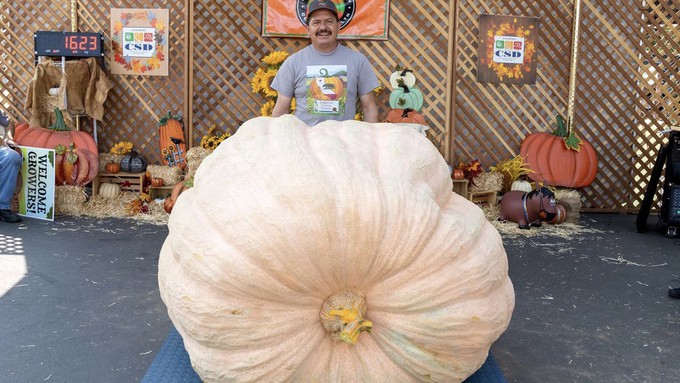
Annual festival celebrates humongous gourds and family fun

Four-time winner Leonardo Urena of Napa poses with his 2021 champion – 1,623 pounds. Photo courtesy of Elk Grove Giant Pumpkin Festival
Where can you see a 1,000-pound pumpkin? Elk Grove, of course, at its annual Giant Pumpkin Festival.
This weekend, Oct. 7 and 8, marks the 29th Giant Pumpkin Festival with plenty of pumpkin to see (and eat!) at Elk Grove Park, 9950 Elk Grove-Florin Road, Elk Grove. Admission is free, but parking is $10 (cash only).
Since 1994, this pumpkin party has grown into the largest salute of its kind in the Sacramento region. Pumpkin growers will haul in their prized giants for the annual weigh-in and a chance at history (as well as cold cash). Last year’s winner (which tipped the scales at 1,866.5 pounds) took home $7,000. The weigh-in starts at 9 a.m. Saturday with winners announced at 4 p.m. Check-in is 7 to 9 a.m.; entry fee is $10 per pumpkin in advance or $25 on Saturday.
Don’t miss the Pumpkin Regatta at noon Sunday. Runner-up pumpkins from the weigh-off are carved into boats and raced across the park’s lake. Anyone (over age 18) with access to a giant floatable pumpkin can enter. Fee is $5 and check-in is 9 a.m. Sunday.
Other contests include a pumpkin recipe contest, cupcake and junior baking contests for kids and teens, a scarecrow contest and youth art contest. (Entry forms and details are available online.)
Expect to find lots of food and fun with food trucks, arts and crafts vendors, carnival rides and, of course, a giant pumpkin patch.
Details and directions: https://www.cosumnescsd.gov/392/Elk-Grove-Giant-Pumpkin-Festival.
Comments
0 comments have been posted.Sacramento Digs Gardening to your inbox.
Food in My Back Yard Series
May 6: Maintain soil moisture with mulch for garden success
April 29: What's (already) wrong with my tomato plants?
April 22: Should you stock up on fertilizer? (Yes!)
April 15: Grow culinary herbs in containers
April 8: When to plant summer vegetables
April 1: Don't be fooled by these garden myths
March 25: Fertilizer tips: How to 'feed' your vegetables for healthy growth
March 18: Time to give vegetable seedlings some more space
March 11: Ways to win the fight against weeds
March 4: Potatoes from the garden
Feb. 25: Plant a fruit tree now -- for later
Feb. 18: How to squeeze more food into less space
Feb. 11: When to plant? Consider staggering your transplants
Feb. 4: Starting in seed starting
Sites We Like
Garden Checklist for week of May 11
Make the most of the lower temperatures early in the week. We’ll be back in the 80s by Thursday.
* Plant, plant, plant! It’s prime planting season in the Sacramento area. Time to set out those tomato transplants along with peppers and eggplants. Pinch off any flowers on new transplants to make them concentrate on establishing roots instead of setting premature fruit.
* Direct-seed melons, cucumbers, summer squash, corn, radishes, pumpkins and annual herbs such as basil.
* Harvest cabbage, lettuce, peas and green onions.
* In the flower garden, direct-seed sunflowers, cosmos, salvia, zinnias, marigolds, celosia and asters. (You also can transplant seedlings for many of the same flowers.)
* Plant dahlia tubers.
* Transplant petunias, marigolds and perennial flowers such as astilbe, columbine, coneflowers, coreopsis, dahlias, rudbeckia and verbena.
* Keep an eye out for slugs, snails, earwigs and aphids that want to dine on tender new growth.
* Feed summer bloomers with a balanced fertilizer.
* For continued bloom, cut off spent flowers on roses as well as other flowering plants.
* Add mulch to the garden to maintain moisture. Mulch also cuts down on weeds. But don’t let it mound around the stems or trunks of trees or shrubs. Leave about a 6-inch-to-1-foot circle to avoid crown rot or other problems.
* Remember to weed! Pull those nasties before they set seed.
* Water early in the day and keep seedlings evenly moist.